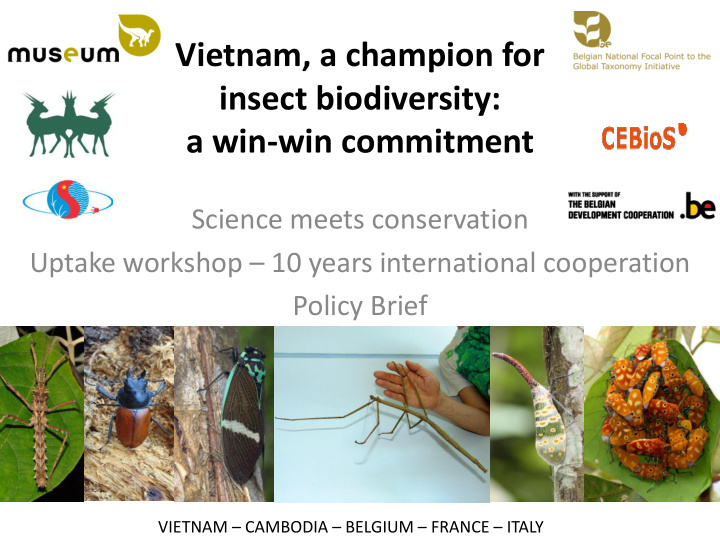



Vietnam, a champion for insect biodiversity: a win-win commitment Science meets conservation Uptake workshop – 10 years international cooperation Policy Brief VIETNAM – CAMBODIA – BELGIUM – FRANCE – ITALY
Contributors • Luca Bartolozzi – Museum of Florence, Italy • Joachim Bresseel – Royal Belgian Institute of Natural Sciences, Brussels, Belgium • Thierry Bourgoin – Muséum national d’Histoire naturelle, Paris, France • Jérôme Constant – Royal Belgian Institute of Natural Sciences, Brussels, Belgium • Eric Guilbert – Muséum national d’Histoire naturelle, Paris, France • Luc Janssens de Bisthoven – Royal Belgian Institute of Natural Sciences, Brussels, Belgium • Sokchan Lorn – Royal Phnom Penh University, Cambodia • Hong Thai Pham – Vietnam National Museum of Nature, Hanoi • Adeline Soulier-Perkins – Muséum national d’Histoire naturelle, Paris, France • Marie-Lucie Susini-Ondafe – Royal Belgian Institute of Natural Sciences, Brussels, Belgium • Sokha Kheam – Royal Phnom Penh University, Cambodia
Vietnam Biodiversity • Vietnam: 16 th most biodiversity rich country • Part of Indo-Burma hotspot designated by Conservation International. • 14 terrestrial ecoregions • 110 key biodiversity areas GTI uptake meeting CEBioS-VNHN, Hanoi, Vietnam, 3-7th April 2017
Vietnam Biodiversity Some general figures: • high level of endemism: 10% of Vietnam’s plants; 12 mammals, 7 birds, 48 reptiles, 33 amphibians, 80 freshwater fish … • 164 terrestrial Protected Areas (32 nat. Parks and 58 nature reserves), covering 7.5% of the country’s total land area, virtually address all of Vietnam's major ecosystems. But what about insect diversity? GTI uptake meeting CEBioS-VNHN, Hanoi, Vietnam, 3-7th April 2017
Importance of insects diversity • Insects = half of known species • Probably 80% of species on Earth • About 20.000 species known from Vietnam = 10% of estimated diversity • Very high level of endemism (species occurring only in Vietnam) Vietnam = Hotspot also for insects!
Case study: the Lacebugs of Vietnam Each new location sampled = discovery of new species! Number of species/sites 50 45 40 35 30 acc sp 25 acc loc 20 15 10 5 0 1906 1913 1920 1927 1934 1941 1948 1955 1962 1969 1976 1983 1990 1997 2004 2011 Year
Case study: the Planthoppers of Vietnam More taxonomic experts Fennah = more new species! 1978 Walker Matsumura 1851 1914 Emeljanov Gnezdilov Constant, Pham
“We only love what we know and we only protect what we love.” Konrad Lorenz
Insect biodiversity in Vietnam even higher than expected Numerous peculiar habitats = Lots of very local species (micro-endemism)
Yunnan China Guangxi Case study: planthopper diversity 677 164 66 Guangdong • Already very diverse but still very poorly 71 known: 255 species in Vietnam More efforts = more species Hainan 110 Thailand 76 Laos 43 Vietnam 255 Cambodia 53
Rich but fragile: threats • Deforestation • Slash and burn agriculture • Mining • Poaching • Pollution
Case study: stick insects Sampled areas Three locations over a short distance: • Bidoup Nui Ba National Park • Phuoc Binh National Park • Nui Chua National Park
Case study: stick insects Each location contains its own unique species Example of high rate of endemism in three protected areas of southern Central Vietnam. Bidoup Nui Ba Nui Chua Phuoc Binh 23 species 19 species 13 species All new 18 new All new Single species present in two locations 60 Km
Case study: stick insects Example of high rate of endemism in three protected areas of southern Central Vietnam Three species of Leaf insects (Bo La – Vietnam Red Book) Phuoc Binh Nui Chua Bidoup Nui Ba 60 Km Important to create more protected areas
Case study: stick insects Ngoc Son – Ngo Luong Area • Recently created (2006) • Connection between Pu Luong and Cuc Phuong National Park (corridor) • Pu Luong: no data • Cuc Phuong: 33 species • Ngoc Son – Ngo Luong: 42 species Important to connect protected areas with corridors
Lessons learnt and thoughts for the future • Science: • Improve collecting and taxonomic capacities • Explore and inventory peculiar habitats • Describe the new species • International collaboration • Complete hotspot status with insect diversity • Management tools: Taxonomic lists, online access, digitalization for Vietnam and for each park • Conservation • Communication • Education • Public awareness • Develop the CBD Clearing House Mechanism (CHM) • Ecotourism
Vietnam = Hotspot also for insects! Each new location sampled = discovery of new species! More taxonomic experts = more new species! More efforts = more species Important to create more protected areas Important to connect protected areas with corridors
Recommend
More recommend